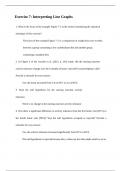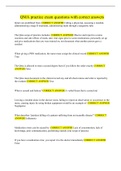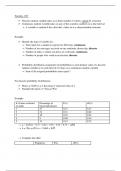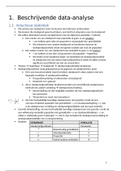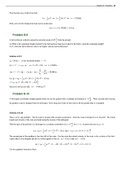SAMENVATTING INFORMATION SYSTEMS STRATEGY &
MANAGEMENT
JULIE VERMEIREN
VUB |
,Summary
Chapter 0: Introduction ................................................................................................................... 4
Chapter 1: The changing and challenging role of IT and the CIO ....................................................... 7
1.1 Setting the stage: Basic concepts ..................................................................................................7
1.1.1 The important role of defining ...............................................................................................7
1.1.2 Informatics .............................................................................................................................8
1.1.3 Information Technology .........................................................................................................8
1.1.4 System ....................................................................................................................................9
1.1.5 Information System ..............................................................................................................10
1.1.6 Data & information ..............................................................................................................10
1.1.7 Model ...................................................................................................................................13
1.1.8 Vision, Mission, Goals, Objectives ........................................................................................15
1.1.9 Strategy ................................................................................................................................19
1.1.10 Tactics .................................................................................................................................19
1.1.11 Management ......................................................................................................................19
1.1.12 Process ...............................................................................................................................20
1.1.12.1 SILO structure ............................................................................................................................. 22
1.1.12.2 Horizontal structure ................................................................................................................... 23
1.1.12.3 Mixed – Matrix structure ........................................................................................................... 23
1.2 Traditional Role of IT ...................................................................................................................24
1.2.1 Value.....................................................................................................................................24
1.2.2 The role of IT ........................................................................................................................25
1.3 The changing and challenging role of IT ......................................................................................27
1.3.1 Business IT alignment ...........................................................................................................28
1.3.1.1 Lifecycle approach ........................................................................................................................ 29
1.3.2 IT infrastructure....................................................................................................................30
1.3.2.1 Enterprise system (ERP) ............................................................................................................... 32
1.3.2.2 Inter-organizational system ......................................................................................................... 33
1.3.2.3 IT rapid evolutions ........................................................................................................................ 33
1.3.2.3.1 Moore’s Law ......................................................................................................................... 33
1.3.2.3.2 Network/Internet technologies ............................................................................................ 34
1.3.2.3.3 Business Information Systems .............................................................................................. 34
1.3.2.3.4 Spread of technology ............................................................................................................ 35
1.3.2.3.5 Importance of adopting new technologies/Innovation cycle ............................................... 35
1.3.2.3.5.1 Missed the boat ............................................................................................................. 36
1.3.2.3.5.2 Importance of being early adopter................................................................................ 38
1.3.3 Knowledge management systems ........................................................................................38
1.3.4 Management Challenges ......................................................................................................39
1.4 The changing and challenging role of the CIO .............................................................................40
1.4.1 Role of the CIO .....................................................................................................................40
1.4.2 IT management ....................................................................................................................41
1.4.3 IT strategy .............................................................................................................................42
1.4.4 The C-suite ............................................................................................................................43
Chapter 2: Business Models and IT ................................................................................................ 45
2.1 Business Models ..........................................................................................................................45
2.1.1 Transformation .....................................................................................................................47
2.1.2 Analyzing strategy ................................................................................................................48
2.1.2.1 Business model strategy audit ..................................................................................................... 50
2.1.3 Analyzing Capabilities ...........................................................................................................51
2.1.3.1 Value Chain .................................................................................................................................. 51
2.1.4 Analyzing value .....................................................................................................................52
2.1.5 Evolving business models/Ansoff Matrix .............................................................................54
2
, 2.1.6 Gartner hypecycle of emerging technologies.......................................................................56
2.1.6.1 Technology adoption cycle and Innovation cycle......................................................................... 61
2.2 IT impact on business models ......................................................................................................62
2.2.1 IT impact map .......................................................................................................................62
2.2.2 Transformation: E-government stage model .......................................................................65
2.2.3 IT impact ...............................................................................................................................65
2.2.3.1 IT impact on strategy.................................................................................................................... 65
2.2.3.1.1 Porter 5 forces ..................................................................................................................... 66
2.2.3.2 IT impact on capabilities............................................................................................................... 67
2.2.3.3 IT portfolio risk/ IT impact on value ............................................................................................. 68
2.2.4 IT business value / Carr ........................................................................................................68
Chapter 3: Strategic Alignment Model ........................................................................................... 70
3.1 Strategic Alignment Model ..........................................................................................................71
3.1.1 Internal vs External IT domain ..............................................................................................73
3.1.2 Strategic Fit...........................................................................................................................75
3.1.3 Functional integration ..........................................................................................................75
3.1.4 Alignment Perspectives / How to achieve business/IT alignment? ......................................76
3.1.1.1 Strategy execution – where business strategy is the driver. ........................................................ 76
3.1.1.2 Technology transformation– where business strategy is the driver. ........................................... 77
3.1.1.3 Competitive potential– where IT strategy is the driver. .............................................................. 77
3.1.1.4. Service level– where IT strategy is the driver.............................................................................. 78
3.2 Business-IT goal modeling .....................................................................................................79
3.2.1 Business motivation model ..................................................................................................80
3.2.2 i*Goal Modeling ...................................................................................................................83
Chapter 4: IT governance ............................................................................................................... 87
4.1 Corporate and IT governance ......................................................................................................87
4.1.1 Corporate governance ..........................................................................................................87
4.1.2 IT governance .......................................................................................................................90
4.1.2.1 IT governance pentagon (COBIT) ................................................................................................. 91
4.1.2.2 IT governance implies control ...................................................................................................... 92
4.2 COBIT ...........................................................................................................................................93
4.3 IT governance implementation, maturity models, and alignment ............................................105
3
, Chapter 0: Introduction
Assistant professor of Business Informatics and Data Analytics, Faculty of Economic and Social
Sciences and Solvay Business School, VUB
Previous:
Dexia Bank, Risk Analytics Department
University of Edinburgh Business School
Ph.D. in Applied Economic Sciences, KU Leuven, 2012
Civil Engineer, KU Leuven, 2007
Research topics:
Data Analytics for business applications
How can organizations make better decisions using data?
Course objectives
What is the course about?
Already quite some time ago Bill Gates stated that “Information technology and business are
becoming inextricably interwoven. I don’t think anybody can talk meaningfully about the one without
talking about the other”. It is exactly that connection – between business and IT – that is the subject
of this course.
To make great decisions, you need data! Understand why you use IT and manage IT(handle and
enhance).
The challenge for business leaders is not simply to manage IT, it is to use IT to deliver business
value.
This course confronts the student with different strategic and managerial issues, challenges,
opportunities and decisions to be made by corporations and organizations with regards to the
development and management of information systems (IS) and information technology (IT).
The course as well aims to provide the students with a set of conceptual tools and approaches
(models, methodologies, frameworks)to handle all these different aspects.
In the first part of the course, starting from a general definition of a business model, the impact of IS
on business models and strategy is discussed, as well as ways to rethink business processes using IT,
for instance by adopting a service-oriented business architecture.
Moreover, IT/IS governance and enterprise architecture frameworks are being introduced as a
means to improve business-IT alignment, and maturity level measurement as a means to assess an
organization’s abilities and skill in aligning and executing strategic IT projects.
4

